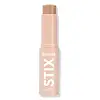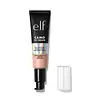What's inside
What's inside
 Key Ingredients
Key Ingredients

 Benefits
Benefits

No benefits
 Concerns
Concerns

 Ingredients Side-by-side
Ingredients Side-by-side

Diisopropyl Dimer Dilinoleate
EmollientLauryl Laurate
Skin ConditioningCaprylyl Methicone
Skin ConditioningPolyethylene
AbrasiveHydrated Silica
AbrasiveParaffin
PerfumingSynthetic Beeswax
Emulsion StabilisingZeolite
AbsorbentDimethicone/Vinyl Dimethicone Crosspolymer
Skin ConditioningCopernicia Cerifera Wax
Boron Nitride
AbsorbentCaprylyl Glycol
EmollientSilica
AbrasiveHydrogenated Soybean Oil
EmollientPhenoxyethanol
PreservativeStearic Acid
CleansingHexylene Glycol
EmulsifyingMicrocrystalline Wax
Emulsion StabilisingDimethicone
EmollientTriethoxycaprylylsilane
Alumina
AbrasiveIron Oxides
CI 77891
Cosmetic ColorantDiisopropyl Dimer Dilinoleate, Lauryl Laurate, Caprylyl Methicone, Polyethylene, Hydrated Silica, Paraffin, Synthetic Beeswax, Zeolite, Dimethicone/Vinyl Dimethicone Crosspolymer, Copernicia Cerifera Wax, Boron Nitride, Caprylyl Glycol, Silica, Hydrogenated Soybean Oil, Phenoxyethanol, Stearic Acid, Hexylene Glycol, Microcrystalline Wax, Dimethicone, Triethoxycaprylylsilane, Alumina, Iron Oxides, CI 77891
Ethylhexyl Methoxycinnamate 7.5%
UV AbsorberTitanium Dioxide 4.45%
Cosmetic ColorantZinc Oxide 13.72%
Cosmetic ColorantWater
Skin ConditioningDimethicone
EmollientCyclopentasiloxane
EmollientButylene Glycol
HumectantPhenyl Trimethicone
Skin ConditioningCetyl PEG/PPG-10/1 Dimethicone
EmulsifyingButylene Glycol Dicaprylate/Dicaprate
EmollientButyloctyl Salicylate
Skin ConditioningPolyglyceryl-4 Isostearate
EmulsifyingMethyl Methacrylate Crosspolymer
Cyclohexasiloxane
EmollientAcrylates/Polytrimethylsiloxymethacrylate Copolymer
Skin ConditioningHexyl Laurate
EmollientMagnesium Sulfate
Phenoxyethanol
PreservativeTriethoxycaprylylsilane
Disteardimonium Hectorite
StabilisingHydrated Silica
AbrasiveAluminum Hydroxide
EmollientPropylene Carbonate
SolventDimethicone/Methicone Copolymer
Caprylyl Glycol
EmollientEthylhexylglycerin
Skin ConditioningDisodium EDTA
Tocopheryl Acetate
AntioxidantSodium Hyaluronate
HumectantNiacinamide
SmoothingPanthenol
Skin ConditioningAscorbyl Palmitate
AntioxidantSoluble Collagen
HumectantCanola Oil
EmollientGlycerin
HumectantDaucus Carota Sativa Seed Oil
EmollientCarbomer
Emulsion StabilisingDaucus Carota Sativa Root Extract
Skin ConditioningHelianthus Annuus Seed Oil
EmollientBeta-Carotene
Skin ConditioningPolysorbate 20
EmulsifyingPalmitoyl Tripeptide-1
Skin ConditioningPalmitoyl Tetrapeptide-7
Skin Conditioning1,2-Hexanediol
Skin ConditioningCI 77891
Cosmetic ColorantCI 77492
Cosmetic ColorantCI 77491
Cosmetic ColorantCI 77499
Cosmetic ColorantEthylhexyl Methoxycinnamate 7.5%, Titanium Dioxide 4.45%, Zinc Oxide 13.72%, Water, Dimethicone, Cyclopentasiloxane, Butylene Glycol, Phenyl Trimethicone, Cetyl PEG/PPG-10/1 Dimethicone, Butylene Glycol Dicaprylate/Dicaprate, Butyloctyl Salicylate, Polyglyceryl-4 Isostearate, Methyl Methacrylate Crosspolymer, Cyclohexasiloxane, Acrylates/Polytrimethylsiloxymethacrylate Copolymer, Hexyl Laurate, Magnesium Sulfate, Phenoxyethanol, Triethoxycaprylylsilane, Disteardimonium Hectorite, Hydrated Silica, Aluminum Hydroxide, Propylene Carbonate, Dimethicone/Methicone Copolymer, Caprylyl Glycol, Ethylhexylglycerin, Disodium EDTA, Tocopheryl Acetate, Sodium Hyaluronate, Niacinamide, Panthenol, Ascorbyl Palmitate, Soluble Collagen, Canola Oil, Glycerin, Daucus Carota Sativa Seed Oil, Carbomer, Daucus Carota Sativa Root Extract, Helianthus Annuus Seed Oil, Beta-Carotene, Polysorbate 20, Palmitoyl Tripeptide-1, Palmitoyl Tetrapeptide-7, 1,2-Hexanediol, CI 77891, CI 77492, CI 77491, CI 77499
Ingredients Explained
These ingredients are found in both products.
Ingredients higher up in an ingredient list are typically present in a larger amount.
Caprylyl Glycol is a humectant and emollient, meaning it attracts and preserves moisture.
It is a common ingredient in many products, especially those designed to hydrate skin. The primary benefits are retaining moisture, skin softening, and promoting a healthy skin barrier.
Though Caprylyl Glycol is an alcohol derived from fatty acids, it is not the kind that can dry out skin.
This ingredient is also used as a preservative to extend the life of products. It has slight antimicrobial properties.
Learn more about Caprylyl GlycolCi 77891 is a white pigment from Titanium dioxide. It is naturally found in minerals such as rutile and ilmenite.
It's main function is to add a white color to cosmetics. It can also be mixed with other colors to create different shades.
Ci 77891 is commonly found in sunscreens due to its ability to block UV rays.
Learn more about CI 77891Dimethicone is a type of synthetic silicone created from natural materials such as quartz.
What it does:
Dimethicone comes in different viscosities:
Depending on the viscosity, dimethicone has different properties.
Ingredients lists don't always show which type is used, so we recommend reaching out to the brand if you have questions about the viscosity.
This ingredient is unlikely to cause irritation because it does not get absorbed into skin. However, people with silicone allergies should be careful about using this ingredient.
Note: Dimethicone may contribute to pilling. This is because it is not oil or water soluble, so pilling may occur when layered with products. When mixed with heavy oils in a formula, the outcome is also quite greasy.
Learn more about DimethiconeHydrated Silica is a type of silicon dioxide. It is called 'hydrated silica' because it is silica with extra bonded water atoms.
It is an absorbent and abrasive, meaning it is exfoliating.
Silica is often used for absorption and can help reduce shine when products are applied.
Learn more about Hydrated SilicaPhenoxyethanol is a preservative that has germicide, antimicrobial, and aromatic properties. Studies show that phenoxyethanol can prevent microbial growth. By itself, it has a scent that is similar to that of a rose.
It's often used in formulations along with Caprylyl Glycol to preserve the shelf life of products.
Triethoxycaprylylsilane is a silicone used to bind and stabilize ingredients.
As an emulsifier, it helps prevent ingredients from separating. This can help elongate the shelf life of products.
Triethoxycaprylylsilane is often used to coat mineral sunscreens ingredients to help give a better feel. It also helps reduce oxidative stress in sunscreens.
Learn more about Triethoxycaprylylsilane